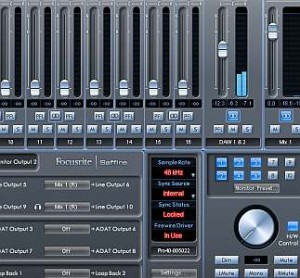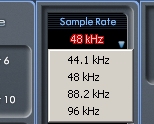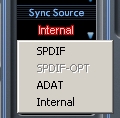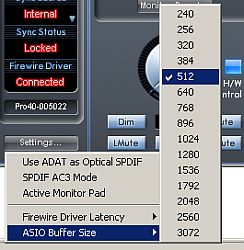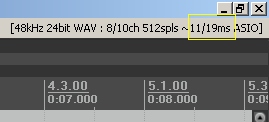Learning and Getting Started with Saffire Pro40 Mix Control
After doing a computer reboot, you can access the mix control in Windows by going to Start — > All Programs — > Focusrite — > Saffire MixControl, then click the Mix Control launcher. It should exactly look like the one below:
The mixcontrol is the heart of your Saffire Pro 40 operations. It commands the hardware inputs and outputs of your audio interface. The mixcontrol is a very powerful tool that you can use whether you want to use the audio interface in live venue or inside your recording studio.
Below are the most important features that you can adjust:
1.) Sample rate – this can only be adjusted if the audio interface is not currently in use or streamed by any ASIO applications.
For example if you are currently running projects in REAPER digital audio workstation, you need to close this project first and exit REAPER. Then in the mix control you can then change the sample rate, by moving your mouse cursor to the drop down.
The following are the options:
There are 4 ways you can adjust the sample rate and these are: 44.1 KHz, 48 KHz, 88.2 KHz and 96 KHz. Most recording applications for TV and film would be using 48 KHz as the sample rate. 44.1 KHz is sufficient for most audio recording applications.
96 KHz is for high-fidelity recording and suitable for any high-end applications. Take note that recording using this sample rate would be consuming a lot of disk space.
It would be surprising that you do not see options for bit depth. By default, professional recording interface such as Saffire Pro 40 would be using 24-bits. But if you would like to select different recording bit depths; it would now be done in your DAW software.
2.) Sync source – digital data needs synchronization methods. This is usually the clock source. The normal operation is to set this to internal. This means there are no digital inputs connected to Saffire pro 40. Digital inputs are usually SPDIF or ADAT. Make sure you set the correct sync source if you are connecting digital inputs.
3.) Settings – this is where you can find the advanced settings for your audio interface. See screenshot below:
For most of the time, you would not need to deal with these settings. The default settings work out fine after installation. For example, there is no latency, drop out and pops/click issues using the ASIO buffer size of 512 and driver latency of medium.
Bear in mind that this depends on the power of your computer hardware, the quality of your DAW and the optimization of your PC for audio. The settings above don’t have any problems with REAPER for both playback and recording in an optimized environment. For details about optimizing PC for audio, Firewire and USB, you can refer to the following tutorials below:
Windows XP/7 Audio Recording DAW Tweaks & Optimization Tips
Optimize Windows XP for Firewire &USB Audio Interface during Recording
Audio Dropout and MultiTrack Recording Latency Troubleshooting Guide
The following are the rules for changing the buffer size and latency in Saffire MixControl:
a.) If you are experiencing latency issues (high latency values reported by your DAW), try setting a small buffer size. Careful about setting too small buffer size in an under-powered CPU because this would result to audible pops or clicks.
For most recording applications, 11ms to 19ms latency is OK. This is measured by most DAW such as in Reaper, see below:
b.) If you are experiencing pops and clicks, try setting a higher buffer size. Although this will solve the pops and clicks, setting too high buffer size would increase the latency which is also not good for playback and recording.
It is why the optimal settings is somewhere in the middle. In the above Saffire Pro 40 settings, the system set it to:
Latency: Medium
Buffer size: 512
Recommended MixControl Settings
Supposing you are using the audio interface for multi-purpose applications such as recording, monitoring, in the box mixing (within your DAW) and usual Windows audio playback; the most recommended configuration is as follows:
1.) Set the routing preset to “DAW Tracking”.
DAW1 and DAW2 corresponds to the master LEFT and RIGHT output of your DAW or multimedia player. This will provide the optimum monitoring environment for tracking and mixing.
“DAW Tracking” also works outside professional music production environment in your computer. It is tested to work well if you are listening to music using Windows media player or using your audio interface when watching movies, etc.
2.) If you are recording, you need to use the headphone and turn the main monitor volume of your audio interface to minimum (no volume output to your nearfield/reference monitor). And then you switch the headphone volume to reasonable levels.
There are two headphone outputs available to Saffire Pro 40. By default, these are the following
Line Outputs 7 and 8 – Headphone 1
Line Outputs 9 and 10 – Headphone 2
If you encounter some issues like no headphone output or volume; something is not set right on the headphone monitor output settings. Look for an example below on how to resolve this:
a.) Look at the monitor preset buttons, see below:
Saffire Pro 40 has 10 analog outputs. In the above screenshot line output 7 and 8 has been marked gray. This means they are switch on and activated to loud volume. However outputs 9 and 10 is not activated and there will be no sound from headphone #2.
First, you need to examine if the routing is done right. See below:
It says that Line output 7 and 8 are routed to received DAW 1 and DAW 2 which is correct. Output 9 and 10 is also routed correctly. If there is no headphone output volume to Headphone #2, then you activate Line output 9 and 10 in the monitor preset buttons.
To do this, you will simply press shift – LEFT click to button 9 and then 10. It will change the color of the buttons to gray:
Once the headphone outputs are activated (7,8,9,10); you can use the headphone outputs when monitoring during the recording session.
Content last updated on July 23, 2012
